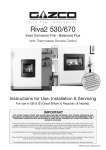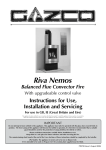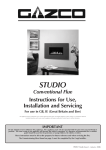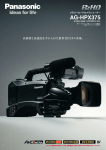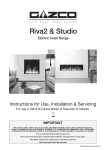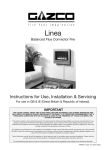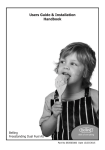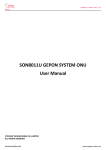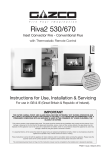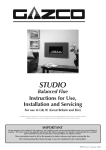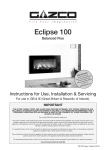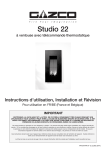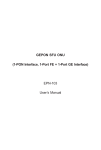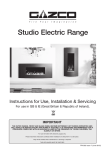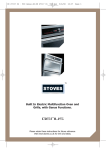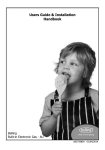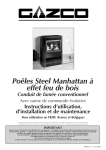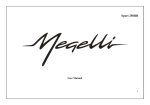Download Riva 53/67
Transcript
Riva 53/67 Inset Convector Fire - Balanced Flue With Upgradeable Control Valve Instructions for Use, Installation & Servicing For use in GB & IE (Great Britain & Republic of Ireland). IMPORTANT THE OUTER CASING, FRONT AND GLASS PANEL BECOME EXTREMELY HOT DURING OPERATION AND WILL RESULT IN SERIOUS INJURY AND BURNS IF TOUCHED. IT IS THEREFORE RECOMMENDED THAT A FIREGUARD COMPLYING WITH BS 8423:2002 IS USED IN THE PRESENCE OF YOUNG CHILDREN, THE ELDERLY OR INFIRM. This product contains a heat resistant glass panel. This panel should be checked during Installation and at each servicing interval. If any damage is observed on the front face of the glass panel (scratches, scores, cracks or other surface defects), the glass panel must be replaced and the appliance must not be used until a replacement is installed. Under no circumstances should the appliance be used if any damage is observed, the glass panel is removed or broken. It is essential that ALL of the screws that retain the glass frame are replaced and tightened correctly. Under no circumstances should the appliance be operated if any of these screws are loose or missing. These Instructions must be left with the appliance for future reference and for consultation when servicing the appliance. Please make the customer aware of the correct operation of the appliance before leaving these instructions with them. The commissioning sheet found on Page 3 of this Instruction manual must be completed by the Installer prior to leaving the premises. PR0639 Issue 12 (February 2014) Contents Riva 53/67 - Balanced Flue Covering the following models: Gas Type Nat. Gas LPG RIVA 53 RIVA 67 8592 8595LUC P8592 P8595LUC Appliance Commissioning Checklist.......................3 User Instructions........................................................4 Installation Instructions...........................................10 Technical Specifications ........................................................... 10 Site Requirements..................................................................... 12 Installation................................................................................. 18 Commissioning.......................................................................... 25 Servicing Instructions..............................................26 Fault Finding.............................................................................. 26 How to Replace Parts............................................................... 28 Basic Spare Parts List............................................................... 33 Service Records........................................................................ 34 2 To receive your Extended Warranty your Gazco appliance must have been purchased from our Expert Retailer Network and registered within one month of purchase or installation. Please note that all warranties are effective from the date of purchase. Any Gazco product purchased outside of our Extended Retailer Network, or not registered within the stated time will carry a standard 12 month warranty. It is a condition of the Extended Warranty that the installation complies with the relevant Building Regulations and is carried out by a suitably trained and qualified individual (GasSafe in the UK or equivalent in other countries) with the certificate of installation and the Commissioning Report on Page 3 completed and retained by the end user. Full terms and conditions are detailed in the Warranty Statement on the Gazco website www.gazco.com. In the event of any conflict of information the wording on the website shall prevail. Important Note: Should any problems be experienced with your product, claims must first be submitted to the Expert Retailer where the appliance was purchased from who will offer immediate assistance or contact Gazco on your behalf. Appliance Commissioning Checklist To assist us in any guarantee claim please complete the following information:- IMPORTANT NOTICE Explain the operation of the appliance to the end user, hand the completed instructions to them for safe keeping, as the information will be required when making any guaranteed claims. FLUE CHECK PASS FAIL 1. Flue Is correct for appliance 2. Flue flow Test 3. Spillage Test GAS CHECK 1. Gas soundness & let by test 2. Standing gas pressure mb 3. Appliance working pressure (on High Setting mb 4. Gas rate m3/h NB All other gas appliances must be operating on full 5. Does Ventilation meet appliance requirements N/A SAFETY CHECK 1. Glass checked to ensure no damage, scratches, scores or cracks. 2. Glass frame secured correctly and all screws replaced RETAILER AND INSTALLER INFORMATION Retailer. . . . . . . . . . . . . . . . . . . . . . . . . . . . . . . . . . . . . . . . . . . . . . . Installation Company. . . . . . . . . . . . . . . . . . . . . . . . . . . . . . . . . . . . . . . . . . . . . . . . . . . . . . . . . . . . . . . . . . . . . . . . . . . . . . . . . . . . . . . . . . . . . . . . . . . . . . . . . . . . . . . . . . . . . . . . . . . . . . . . . . . . . . . . . . . . . . . . . . . . . . . . . . . . . . . . . . . . . . . . . . . . . . . . . . . . . . . . . . . . . . . . . . . . . . . . . . . . . . . . . . . . . . . . . . . . . . . . . . . . . . . . . . . . . . . . . . . . . . . . . . Contact No.. . . . . . . . . . . . . . . . . . . . . . . . . . . . . . . . . . . . . . . . . . . Engineer. . . . . . . . . . . . . . . . . . . . . . . . . . . . . . . . . . . . . . . . . . . . . Date of Purchase. . . . . . . . . . . . . . . . . . . . . . . . . . . . . . . . . . . . . Contact No.. . . . . . . . . . . . . . . . . . . . . . . . . . . . . . . . . . . . . . . . . . Model No. . . . . . . . . . . . . . . . . . . . . . . . . . . . . . . . . . . . . . . . . . . . . Gas Safe Reg No. . . . . . . . . . . . . . . . . . . . . . . . . . . . . . . . . . . . Serial No.. . . . . . . . . . . . . . . . . . . . . . . . . . . . . . . . . . . . . . . . . . . . . Date of Installation. . . . . . . . . . . . . . . . . . . . . . . . . . . . . . . . . . Gas Type. . . . . . . . . . . . . . . . . . . . . . . . . . . . . . . . . . . . . . . . . . . . . 3 User Instructions Welcome Congratulations on purchasing your Riva fire, if installed correctly Gazco hope it will give you many years of warmth and pleasure for which it was designed. The purpose of this manual is to familiarise you with your appliance, and give guidelines for its installation, operation and maintenance. If, after reading, you need further information, please do not hesitate to contact your Gazco retailer. WARNING In the event of a gas escape or if you can smell gas, please take the following steps: • Immediately turn off the gas supply at the meter/emergency control valve • Extinguish all sources of ignition • Do not smoke • Do not operate any electrical light or power switches (On or Off) • Ventilate the building(s) by opening doors and windows • Ensure access to the premises can be made Please report the incident immediately to the National Gas Emergency Service Call Centre on 0800 111 999 (England, Scotland and Wales) , 0800 002 001 (N. Ireland) or in the case of LPG, the gas supplier whose details can be found on the bulk storage vessel or cylinder. The gas supply must not be used until remedial action has been taken to correct the defect and the installation has been recommissioned by a competent person. 1. General 1.1 Installation and servicing must only be carried out by a competent person whose name appears on the Gas Safe register. To ensure the engineer is registered with Gas Safe they should possess an ID Card carrying the following logo: 1.3 Do not place curtains above the appliance: You must have 300mm (1’) clearance between the appliance and any curtains at either side. 1.4 No furnishings or other objects should be placed within 1 metre of the front of the appliance. 1.5 If a shelf is fitted, a distance of 150mm above the appliance is required. 1.6 If any cracks appear in the glass panel do not use the appliance until the panel has been replaced. 1.7 If, for any reason, the flue has to be removed from the appliance, the seals must be replaced in the inner spigot. 1.8 Do not obstruct the flue terminal in any way, i.e. by planting flowers, trees, shrubs etc. in the near vicinity, or by leaning objects against the terminal guard. 1.9 Do not put any objects on the terminal guard; it will lose its shape. 1.10 If you use a garden sprinkler, do not let quantities of water into the flue terminal. 1.11 In the unlikely event the appliance is receiving interference from other electronic devices, the handset/Control box can be reprogrammed. Please consult your retailer if you think this may be the case. 1.12 This product is guaranteed for 5 years from the date of installation, as set out in the terms and conditions of sale between Gazco and your local Gazco retailer. Please consult with your local Gazco retailer if you have any questions. In all correspondence always quote the Model Number and Serial Number. 2. Operating the Appliance 2.1 The control valve is at the foot on the right-hand side of the appliance. It has two controls, Diagram 1: 1. The right-hand knob controls the pilot ignition 2. The left-hand knob controls the main burner 2.2 Refer to separate instructions if your appliance is upgraded to include battery remote control. The instructions below apply whether or not you have the remote upgrade. Lighting the Pilot 2.3 1 1.2 4 In all correspondence, please quote the appliance type and serial number, which can be found on the data badge located on a plate attached to the lower slotted trim. To start the left-hand and right-hand control knobs must both point to off ( ): User Instructions 2.4 Press in the right-hand control knob and rotate anticlockwise until a click is heard. Continue to press in. The knob points to the pilot ( ). The pilot is lit Standard Remote Control (PART NUMBER 8455) 4.3 This remote control can control the gas appliance after the pilot has been lit. It can turn the main burner on and regulate it from low through to high and back again. It can turn the main burner off leaving the pilot burning. 2.5 Keep the knob depressed for 10 seconds before releasing. The pilot remains lit. Repeat the above steps if the pilot does not stay lit NOTE: If the pilot goes out, the Interlock system prevents you lighting again for a short period 2.6 If, after repeating the above steps the pilot does not light, contact your Retailer or Installer. 4.4 2.7 Turn the right-hand knob to the left to main burner setting ( ) MANUAL MODE Adjusting the Flame height 2.8 You can now adjust the flame height and temperature using the left-hand control knob. 2.9 Turn the left-hand knob anti-clockwise to increase the flame height Thermostatic and Timer Remote Control (PART NUMBER 8456) Can be used to turn the main burner on and manually regulate it from low through to high and back again. It can also be used to turn the main burner off leaving the pilot burning. AUTO MODE Will automatically regulate the room to a pre-set temperature. 2.10 Turn clockwise to decrease the height IMPORTANT: YELLOW FLAMES TYPICALLY APPEAR WHEN THE APPLIANCE HAS REACHED NORMAL OPERATING TEMPERATURE. THIS CAN TAKE UP TO 30 MINUTES. WARNING: IF THE APPLIANCE FAILS TO LIGHT OR BECOMES EXTINGUISHED IN USE, WAIT 3 MINUTES BEFORE ATTEMPTING TO RELIGHT. 3. Turning OFF the Appliance 3.1 To turn the main burner off turn the left-hand knob until it points to off ( ).Just the pilot remains lit. 3.2 Press in and turn the right-hand knob until it points to off ( ). The pilot goes out. This remote control can control the gas appliance after the pilot has been lit. TIMER MODE Will turn the appliance on and off according to a pre-set programme and automatically regulate the room temperature during the two on periods. 5. Cleaning the Appliance ENSURE THE APPLIANCE IS COLD BEFORE PROCEEDING 5.1 Remove the Profil frame from the appliance by removing the 2 concealed screws behind the lower access door, see Diagram 2. Pull the frame forward at the bottom then lift clear of the top fixing lugs. 2 4. Upgrading the Appliance 4.1 4.2 The appliance is fitted with a control valve that can easily be upgraded to battery powered remote control. There are two versions of this control which can be obtained through your local Gazco stockist. There is no requirement for this upgrade to be carried out by an approved Gas engineer. However Gazco recommend that this task is undertaken by a suitably competent person. This upgrade can be fitted before or after installation but if side clearances are limited then it will be easier to upgrade the appliance before installation. Full instructions are included with the kit. Note: If the appliance is fitted with an alternative Gazco Riva front, please refer to the separate instructions supplied with the front. 5 User Instructions 5.2 Remove the glass door by unscrewing the screws, see Diagram 3, arrow A. 6. Arrangement of Fuel Bed 3 Advice on handling and disposal of fire ceramics 5.3 Remove the ceramic logs and granules, and place them on a dry, clean surface. 5.4 The logs should not require cleaning. Do not use a vacuum cleaner or brush to clean the logs, any large pieces of debris may be removed by hand. 5.5 Ensure any debris is removed from the burner ports. 5.6 Replace the ceramics by referring to Section 6. 5.7 Use a damp cloth to clean the outer casing of the appliance. 5.8 To clean the glass surface, Gazco recommends you use a ceramic glass product generally sold for cleaning ceramic hobs. NEVER OPERATE THE APPLIANCE WHEN THE GLASS FRAME IS REMOVED OR BROKEN. 5.9 Replace ALL of the securing screws ensuring that a screw is present in all fixing slots. UNDER NO CIRCUMSTANCES SHOULD THE APPLIANCE BE USED IF ANY OF THE GLASS FRAME RETAINING SCREWS ARE LOOSE OR MISSING 5.10 Replace the decorative front by referring to the separate instructions supplied with the front. 6 NOTE: ENSURE THAT THE LOGS ARE POSITIONED CORRECTLY, SEE SECTION 6. ONLY USE THE CORRECT AMOUNT OF LOGS AS SPECIFIED IN THE DIAGRAMS. The fuel effect and side panels in this appliance are made from Refractory Ceramic Fibre (RCF), a material which is commonly used for this application. Protective clothing is not required when handling these articles, but we recommend you follow normal hygiene rules of not smoking, eating or drinking in the work area and always wash your hands before eating or drinking. To ensure that the release of RCF fibres are kept to a minimum, during installation and servicing a HEPA filtered vacuum is recommended to remove any dust accumulated in and around the appliance before and after working on it. When servicing the appliance it is recommended that the replaced items are not broken up, but are sealed within heavy duty polythene bags and labelled as RCF waste. RCF waste is classed as stable, non-reactive hazardous waste and may be disposed of at a licensed landfill site. Excessive exposure to these materials may cause temporary irritation to eyes, skin and respiratory tract; wash hands thoroughly after handling the material. Riva 67 Layout THE BAG OF GRANULES CONTAINED IN THE LOG SET IS TO SIMULATE AN ASH EFFECT. THIS IS NOT TO BE PLACED ON THE BURNER. 6.1 Place some of the granules around the rear and sides of the burner tray. ENSURE NO GRANULES FALL ON THE BURNER, see Diagram 4. 4 User Instructions 6.2 Place log 1 (large black log) on the burner. Ensure the rear of the log touches the rear of the burner, see Diagram 5. 8 5 6.6 CENTRALISE THE LOG BETWEEN THE BURNER PORTS AT EITHER END. ALL THE REMAINING LOGS EXCEPT FOR THE SMALLEST ONE HAVE LOCATION HOLES ON THE UNDERSIDE, THESE LOCATE ON THE STUDS AT THE FRONT OF THE APPLIANCE. 6.3 Place log 5 on top of log 4 and ensure the two large locations engage. Locate the front of the log on to the far right-hand stud, see Diagram 9. 9 Place log 2 on the centre and locate the rear of the log on the large flat area of log 1, see Diagram 6. 6 6.7 Place log 6 on the remaining stud and lean the log on to log 1 between logs 2 and 3. There is a notch to locate the log, see Diagram 10. 10 6.4 Place log 3 on the far left-hand stud. The recess on the underside of the log should locate on the top of log 1 on the far left-hand side, see Diagram 7. 7 6.5 Place log 4 on the right-hand side of the centre log. There is a large recess on the underside of the log, which is located on log 1, see Diagram 8. 6.8 Place log 7 at the front of the appliance between logs 4 and 5. DO NOT PLACE THIS LOG ON THE BURNER. IT IS ONLY TO FILL THE GAP BETWEEN LOGS 4 AND 5. The charred effect should face the rear of the appliance. Place the remaining granules between the logs so that they cover the front metal ledge, see Diagram 11. ENSURE NO GRANULES FALL ON THE BURNER. 7 User Instructions 14 11 Riva 53 Layout 6.9 6.12 Place log B on the first stud. The recess on the underside of the log should locate on the top of log C, see Diagram 15. 15 Place log A on to the burner. Ensure the rear of the log touches the rear burner, see Diagram 12. 12 6.13 Place log E on the last stud. The recess on the underside of the log should locate on to the top of log D, see Diagram 16. 16 CENTRALISE THE LOG BETWEEN THE BURNER PORTS AT EITHER END. Four of the remaining logs have location holes on the underside. These locate on the studs at the front of the appliance 6.10 Place log D on the third stud from the left and resting at the rear on log A, see Diagram 13. 13 6.14 Place log F on the rear tray and leaning forward to locate in the recess in log E, see Diagram 17. 17 6.11 Place log C on the second stud resting at the rear on log A., see Diagram 14. 8 User Instructions 6.15 Place log G at the front of the appliance between logs D and E. DO NOT PLACE THIS LOG ON THE BURNER. IT IS ONLY TO FILL THE GAP BETWEEN LOGS D AND E. The charred effect should face the rear of the appliance, see Diagram 18. 8. Running In 8.1 During initial use of a new Gazco appliance a strong odour will be encountered as various surface coatings become hot for the first time. Although these odours are harmless it is recommended that the appliance is operated on maximum for 4 to 8 hours in order to fully burn off these coatings. After this period the odours should then disappear. If the odours persists, please contact your installer for advice. 8.2 During the first few hours of burning there may be discolouration of the flames. This will also disappear after a short period of use. 18 9. Servicing 9.1 6.16 With the granules fill the front compartment around the logs evenly. ENSURE NO GRANULES FALL ON THE BURNER, see Diagram 19. The appliance must be serviced every 12 months by a qualified Gas Engineer. In all correspondence always quote the Model number and the Serial number which may be found on the data badge. 10. Ventilation 19 10.1 Any purpose provided ventilation should be checked periodically to ensure that it is free from obstruction. 11. Installation Details 11.1 Your installer should have completed the commissioning sheet at the front of this book. This records the essential installation details of the appliance. In all correspondence always quote the Model number and Serial number. 6.17 Ensure that the fibreglass seal on the back of the glass frame is intact then hook the location tabs over the hooks on the top of the firebox. Replace the six screws working from the top down. Tighten the screws evenly. DO NOT OVER TIGHTEN. NEVER OPERATE THE APPLIANCE WHEN THE GLASS PANEL IS REMOVED OR BROKEN. 6.18 Replace the Profil frame by hooking the top over the location lugs on top of the flanges, replace the two fixing screws., see Diagram 2, Section 5 'Cleaning the Appliance'. Note: If the appliance is fitted with an alternative Gazco Riva front, please refer to the separate leaflet supplied with the front. 7.1 12. Hot Surfaces 12.1 Parts of this appliance become hot during normal use. 12.2 Regard all parts of the appliance as a working surface. 12.3 Provide a suitable fire guard to protect young children and the infirm. 12.4 If frames other than the Profil are being fitted, refer to their instructions. 20 NOTE: ENSURE THAT THE LOGS ARE POSITIONED AS ABOVE. ONLY USE THE CORRECT AMOUNT OF LOGS AS SPECIFIED IN THE DIAGRAMS. 7. Flame Failure Device = Hot Surface This is a safety feature incorporated on this appliance which automatically switches off the gas supply if the pilot goes out and fails to heat the thermocouple. IF THIS OCCURS DO NOT ATTEMPT TO RELIGHT THE APPLIANCE FOR 3 MINUTES. 9 Installation Instructions Technical Specification Covering the following models: Gas Type RIVA 53 RIVA 67 Nat. Gas 8592 8595LUC P8592 P8595LUC LPG Model Gas CAT. Riva 53 I2H Riva 53 I3+ Riva 67 I2H Riva 67 I3+ Gas Type Working Pressure Aeration Natural (G20) 20mb Butane (G30) 29mb 15 x 17 Propane (G31) 37mb BLANK Natural (G20) 20mb Butane (G30) 29mb 14 x 16 Propane (G31) 37mb 6x6 Injector 14mm 16mm Open 1 side 15mm x 17mm Open 1 side *LPG models. The appliance is factory set to run on butane G30. If it is intended to be used on propane G31 the aeration plate supplied must be fitted. To change aeration plate refer to section replacing parts 9. Gas Rate m3/h 530 Input kW (Gross) 0.648 0.180 200 0.237 410 0.581 0.166 185 0.218 High Low 6.8 3.25 GB, IE 6.3 3.25 GB, IE 6.1 3.0 GB, IE 5.8 3.0 GB, IE Efficiency Class 2 Flue Outlet Size 100 Ø / 152mm Ø Gas Inlet Connection Size 8mm Ø RESTRICTOR REQUIREMENT VERTICAL & HORIZONTAL FLUE SPECIFICATION Vertical flue height from top of appliance Horizontal length Restrictor size 200 x 500mm Up to 500mm No Restrictor 500mm x 1000mm Up to 1000mm No Restrictor 1000mm x 1490mm Up to 1000mm 70mm Ø 1500mm x 1990mm Up to 5000mm 70mm Ø 2000mm x 3000mm Up to 5000mm 60mm Ø TOP EXIT-VERTICAL ONLY INCLUDING OFFSET 10 Country Vertical flue height from top of appliance Restrictor size 3000mm x 4990mm 52mm Ø 5000mm x 10000mm 47mm Ø Installation Instructions Technical Specification This appliance has been certified for use in countries other than those stated. To install this appliance in these countries, it is essential to obtain the translated instructions and in some cases the appliance will require modification. Contact Gazco for further information. NOTE: All dimensions refer to the Riva 53 & Riva 67 when fitted with the Profil front. Please refer to the separate Installation leaflet supplied with any alternative Gazco Riva front for applicable dimensions. PACKING CHECKLIST Qty Description Fixing Kit containing: 1 x Cassette and burner assembly 1 x Decorative frame 1 x Ceramic back panel * 1 x Ceramic LH side panel * 1 x Ceramic RH side panel * 1 x Log set (7 logs) 1 x Bag of granules 1 1 4 4 1 2 x x x x x x Fixing kit containing: Instruction manual Woodscrews Rawlplugs Self adhesive foam strip Frame retaining screws * Fitted in appliance RIVA 53 DV 24 118 705 41 24 565 660 30 339 398 82 534 RIVA 67 DV 24 659 41 24 570 339 30 525 83 524 118 692 11 Installation Instructions Site Requirements 1. Flue & Chimney Requirements NOTE: This appliance can only be installed in conjunction with the flue supplied. 1.1 The flue must be sited in accordance with BS5440: Part 1 (latest edition) (see Diagram below). 1.2 Any terminal which is less than 2 metres above any access (level ground, balcony or above a flat roof to which people have access) is to be fitted with a guard. 1.3 All vertical and horizontal flues must be securely fixed and fire precautions followed in accordance with local and national codes of practice. 1 12 1.4 A restrictor may be required, see Technical Specifications on page 15. 1.5 Two types of flue terminals are available, horizontal and vertical. For a horizontal terminal, decide on the terminal position and measure the height from the top of the appliance to the centre of the required hole. For minimum and maximum flue dimensions, see Diagram 1A/1B. 1.6 Access must be left either above or at the side of the installation to allow the flue to be assembled on top of the appliance. When a horizontal terminal is used, the vertical sections are assembled first, then the 90-degree elbow and finally the horizontal section including the terminal. If a masonry installation is to be built, a suitable lintel must be used to support the opening. 1.7 Only the horizontal terminal section can be reduced in size. Installation Instructions Site Requirements 2. Flue Options 1C 1A Start of bend to centre line of horizontal flue 170mm. Centre line of vertical flue to end of bend 220mm. 1B 2.1 TOP FLUE UP & OUT KIT (8534/8534AN) Vertical from the top of the appliance then horizontally out. see diagram 1A. The basic kit comprises: 1 x 200mm vertical length 1 x 500mm terminal length (cut to length on site) 1 x 90 degree elbow 1 x wall plate 1 x 70mm restrictor 1 x 60mm restrictor fixing screws The kit may be used on its own. (Note – with a 200mm rise only the 500mm terminal length can be used). Extra lengths may be added to the vertical and horizontal, see Section 2.5. 2.2 TOP FLUE UP & OUT WITH ADDITIONAL BEND Any additional bend may be used on the horizontal section (either 45° or 90°), but the overall horizontal flue run will be reduced. Refer to diagram 1B. 2.3 TOP FLUE VERTICAL KIT (8524/8524AN) Vertical from the top of the appliance, see Diagram 1C. A minimum vertical rise 3m (9’10") to a maximum 10m (32’10"). The basic kit comprises: 2 x 1m lengths 1 x 1m terminal length 1 x 52mm restrictor 1 x 47mm restrictor Extra lengths may be added, see Section 2.5. 13 Installation Instructions Site Requirements 2.4 TOP FLUE VERTICAL OFFSET KIT (8530/8530AN) 3.5 Used with kit 8524. A minimum rise of 500mm (191/2) is required to the first bend, see Diagram 1C. All supply gas pipes must be purged of any debris that may have entered, prior to connection to the appliance. 3.6 2.5 EXTRA FLUE LENGTHS The gas supply enters through the silicone panel located on the RH side of the outer box; this will need to be slit with a sharp knife prior to passing the supply pipe through. All flue components are 150mm diameter (6") Nominal Length Actual Length Stainless Finish 4. Ventilation Anthracite Finish 200mm 140mm 8527 8527AN 500mm 440mm 8528 8528AN 1000mm 940mm 8529 8529AN 40° Bend N/A 8507 8507AN 90° Bend N/A 8508 8508AN 4.1 This appliance requires no additional ventilation. 5. Appliance Location 5.1 This appliance must stand on a non-combustible hearth that is at least 12mm thick; the minimum opening dimensions are shown in Diagram 2a. 2a NOTE: The following areas need careful consideration. a)Terminal positions b)Flue supports c)Weatherproofing d)Fire precautions For all the above options, local and national codes of practice must be adhered to. 3. Gas Supply 3.1 3.2 3.3 Before installation, ensure that the local distribution conditions (identification of the type of gas and pressure) and the adjustment of the appliance are compatible. Ensure that the gas supply is capable of delivering the required amount of gas and is in accordance with the rules in force. 3.4 14 This appliance is supplied complete with a factory fitted isolation device incorporated into the inlet connection, no further isolation device is required. Riva 53 Riva 67 A 540mm 668mm B 350mm 350mm C 665mm 530mm 5.2 NOTE: If this appliance is fitted less than 150mm from the floor then it will require a hearth to protect the floor. It should have minimum dimensions of 12mm thick projecting 300mm in front and 150mm either side of the appliance. 5.3 This appliance is not suitable for installation onto a combustible wall; all combustible materials must be removed from the area shown in Diagrams 2B & 2C. 5.4 NOTE: If using natural materials for the back panel of the fireplace, it is recommended that you construct it from three or more sections to prevent cracking. Resin-based materials may not be suitable. This appliance is an effective heat producer and attention must be paid to the construction and finish of the fireplace. Soft copper tubing can be used to install the appliance. Soft soldered joints can be used externally of the appliance but must be restricted to the area shown in Diagram 2. 2 Dimensions Installation Instructions Site Requirements 2B Riva 53 855 3B RIVA 67 700 900 200 MINIMUM COMBUSTIBLE MATERIAL CLEARANCES FOR RIVA 67 150 2C 555 Riva 67 560 710 150 980 150 3A Do not pack the void around or above the appliance with insulation materials such as mineral wool. 5.7 The void into which the cassette is fitted must be ventilated to prevent a build up of heat. If the void is sealed then it will be necessary to fit vents at both low and high levels of approximately 50cm2 each. These vents should take cold air from the room and return warm air back into the room. 5.8 A removable access hatch must be left in the side of the chimney breast for future servicing and inspection of the appliance. 5.9 Build the studwork chimney breast to the desired size. Ensure that the clearances to combustible materials is maintained, decide upon and cut the hole for the flue exit (see Site Requirements, Section 2). It is recommended to line the aperture for the cassette with 12mm thick noncombustible material as shown. Provide gas and electric services (if required) into the enclosure, see Diagram 4. 680 STUDWORK INSTALLATION 5.5 5.6 Combustible parts of the studwork must not be any closer than the minimum dimensions, see Diagrams 3A &B. These dimensions need to be maintained even if the frame work is protected by non-combustible material. RIVA 53 MINIMUM COMBUSTIBLE MATERIAL CLEARANCES FOR RIVA 53 4 15 Installation Instructions Site Requirements 5.10 Place the cassette into position and fit a non-combustible panel above the cassette as shown, see Diagram 5. Ensure the void is adequately ventilated. 7 5 5.13 A removable access hatch must be left in the side of the chimney breast for future servicing and inspection of the appliance. 5.11 With the cassette forward of its final position apply plasterboard to the front of the chimney breast and apply plaster finish. In order to prevent possible plaster cracks, it is recommended to cover the face of the wall immediately above the cassette with non-combustible material such as marble or granite, see Diagram 6. 6 MASONRY INSTALLATION 5.14 If it is necessary to install this appliance into a noncombustible e.g. masonry or brickwork, minimal clearances are required, however due to the flue spigot protruding from the top of the appliance, the following method is recommended. 5.15 Mark out the following: A. Cassette position B. Extra room below the cassette C. Lintel position D. Flue installation access NOTE: The position of the flue installation access will depend on the route and length of flue to be installed. A hole will be required to gain access to each joint and the exit through the wall. These holes are ideally in the side of the chimney breast, see Diagram 8. 8 5.12 Push the cassette back into its final position and connect the flue system, gas and electric services using the openings in the side of the chimney breast for access. Following commissioning complete the sides of the chimney breast, see Diagram 7. 16 Installation Instructions Site Requirements 5.16 Cut out all holes and fit lintel, see Diagram 9. 9 5.19 Raise the cassette into its final position and support it on 12mm thick non-combustible material, see Diagram 12. 12 5.17 Apply plaster finishing around the aperture that the cassette will fit into, see Diagram 10. 10 5.20 Connect the flue system through the access holes, see Diagram 13. 13 NOTE: In order to prevent possible plaster cracks, it is recommended to cover the immediate area above the cassette with non-combustible material such as marble or granite. 5.18 Place the cassette into the opening, see Diagram 11. 5.21 After fully commissioning the appliance, make good all of the access holes, see Diagram 14. NOTE: It is recommended to cover some of these access holes with removable panels to assist in future servicing, see Diagram 14. 11 14 17 Installation Instructions 1. Safety Precautions 1.1 For your own and other’s safety, you must install this fire according to local and national codes of practice. Failure to install the fire correctly could lead to prosecution. Read these instructions before installing and using this appliance. 1.2 These instructions must be left intact with the user. 1.3 Do not attempt to burn rubbish on this appliance. 1.4 Keep all plastic bags away from young children. 1.5 Do not place any object on or near to the appliance and allow adequate clearance above the appliance. IF THE APPLIANCE IS EXTINGUISHED OR GOES OUT IN USE, WAIT 3 MINUTES BEFORE ATTEMPTING TO RELIGHT THE APPLIANCE. IMPORTANT: REFER TO DATA BADGE AND TECHNICAL SPECIFICATION AT THE FRONT OF THE MANUAL TO ENSURE THE APPLIANCE IS CORRECTLY ADJUSTED FOR THE GAS TYPE AND CATEGORY APPLICABLE IN THE COUNTRY OF USE. LPG MODELS: THE APPLIANCE IS FACTORY SET TO RUN ON BUTANE (G30). IF IT IS INTENDED TO BE USED ON PROPANE (G31) THE AERATION PLATE SUPPLIED MUST BE FITTED. TO CHANGE AERATION PLATE REFER TO SECTION 9, REPLACING PARTS. Standard Remote Control (PART NUMBER 8455) 2.3 Thermostatic and Timer Remote Control (PART NUMBER 8456) 2.4 Can be used to turn the main burner on and manually regulate it from low through to high and back again. It can also be used to turn the main burner off leaving the pilot burning. AUTO MODE Will automatically regulate the room to a pre-set temperature. TIMER MODE Will turn the appliance on and off according to a pre-set programme and automatically regulate the room temperature during the two on periods. 3. Installation of the Appliance NOTE: THERE IS AN OPTIONAL CONVECTION FAN KIT AVAILABLE CODE No. 8576 (53) AND 8571 (67). THIS CAN BE FITTED EITHER DURING OR AFTER INSTALLATION, BUT PROVISION FOR A POWER SUPPLY MUST BE MADE PRIOR TO INSTALLATION OF THE APPLIANCE. ALSO THERE IS A DUCT KIT, CODE No. 8572 WHICH MUST BE INSTALLED AT THE SAME TIME AS THE APPLIANCE INSTALLATION. Unpacking Remove the appliance from its packaging, and check that it is complete and undamaged. Put the loose ceramic parts to one side so that they are not damaged during installation. 1.7 If you have purchased a Profil decorative front, this will be located inside the cardboard fitment situated in front of the Riva cassette, remove from packing and place to one side until required. 2. Upgrading the Appliance 2.1 2.2 18 The appliance is fitted with a control valve that can easily be upgraded to battery powered remote control. There are two versions of this control which can be obtained through your local Gazco stockist. There is no requirement for this upgrade to be carried out by an approved Gas engineer. However Gazco recommend that this task is undertaken by a suitably competent person. This upgrade can be fitted before or after installation but if side clearances are limited then it will be easier to upgrade the appliance before installation. Full instructions are included with the kit. This remote control can control the gas appliance after the pilot has been lit. MANUAL MODE FOR DETAILS OF CHANGING BETWEEN GAS TYPES REFER TO SERVICING, SECTION 10, REPLACING PARTS. 1.6 This remote control can control the gas appliance after the pilot has been lit. It can turn the main burner on and regulate it from low through to high and back again. It can turn the main burner off leaving the pilot burning. 3.1 1 Remove the glass door by unscrewing the 9 x retaining screws, see Diagram 1. Carefully remove the box containing the logs from the firebox. Place to one side as these are fragile. The ceramic brick effect is factory fitted, take care not to damage these components. Installation Instructions 3.2 The gas supply enters through the silicone panel located on the RH side of the outer box; this will need to be slit with a sharp knife prior to passing the supply pipe through. 3.3 Two types of flue terminals are available, horizontal and vertical. For a horizontal terminal, decide on the terminal position and measure the height from the top of the appliance to the centre of the required hole. For minimum and maximum flue dimensions, see Diagram 2. TAKE CARE WHEN MARKING OUT FOR THE FLUE AS IT IS DIFFICULT TO MOVE AFTER INSTALLATION. IF A RESTRICTOR IS REQUIRED FIT THIS BETWEEN THE SMALL OUTLET SPIGOT AND THE AIRDUCT SEE DIAGRAM 3. REFER TO TECHNICAL SPECIFICATIONS FOR RESTRICTOR SIZE. 3 2 3.4 3.5 A 152mm (6") diameter hole is required to install the flue. This can be achieved by either: a) Core drill b) Hammer and chisel. It is advisable to drill small holes around the circumference when using method b. Make good both ends of the hole. Remove the backing paper from the silicone foam strip supplied in the fixing kit and fix to the back of the outer flanges of the appliance, ensure that it is located below the frame location lugs on the top flange. Foam strip may need cutting to length. RESTRICTOR REQUIREMENT VERTICAL & HORIZONTAL FLUE SPECIFICATION Vertical flue height from top of appliance Horizontal length Restrictor size 200mm x 500mm Up to 500mm No Restrictor 500mm x 1000mm Up to 1000mm No Restrictor 1000mm x 1490mm Up to 1000mm 70mm Ø 1500mm x 1990mm Up to 5000mm 70mm Ø 2000mm x 3000mm Up to 5000mm 60mm Ø TOP EXIT-VERTICAL ONLY INCLUDING OFFSET Vertical flue height from top of appliance Restrictor size 3000mm x 4990mm 52mm Ø 5000mm x 10000mm 47mm Ø 19 Installation Instructions 3.6 When installing the appliance into a combustible enclosure, ensure all the clearances are observed. It is advisable to use a marble slip or similar material between the appliance and the plasterboard, see Site Requirements Diagram 3A and 3B. 3.9 There is a cardboard fitment in the terminal. This is to support the flue whilst it is cut to length. REMOVE THE REMAINDER OF THE CARDBOARD AFTER CUTTING TO SIZE, see Diagram 6. 6 Secure the appliance through the four fixing holes using the screws provided, see Diagram 4. 4 3.7 Access must be left either above or at the side of the installation to allow the flue to be assembled on top of the appliance. When a horizontal terminal is used, the vertical sections are assembled first, then the 90-degree elbow and finally the horizontal section including the terminal. If a masonry installation is to be built, a suitable lintel must be used to support the opening. 3.8 Only the horizontal terminal section can be reduced in size. To determine the length, measure from the outside of the wall to the stop on the 90-degree elbow. Measuring from the slots on the outer flue furthest away from the outlet, add 10mm onto the required measured length and mark around the flue, see Diagram 5. A wall plate is supplied to secure the flue to the wall. Bend the tab to 90 . Assemble the plate onto the flue but only secure to the wall and flue when the flue is fully assembled, see Diagram 5. 3.10 Remove the compression elbow from the appliance and connect it to the gas supply pipe. As the appliance is located into the enclosure, pass the elbow and supply pipe through the silicone panel on the RH side. PURGE THE SUPPLY PIPE. This is essential to expel any debris that may block the gas controls. Connect the elbow to the appliance inlet pipe, see Diagram 7. 7 5 4. Gas Soundness Pressure Check 4.1 20 Connect a suitable pressure gauge to the test point located on the inlet fitting and turn the gas supply on. Light the appliance and check all gas joints for possible leaks. Turn the appliance to maximum and check that the supply pressure is as stated on the databadge. Turn the gas off and replace the test point screw, turn the gas on and check the test point for leaks. Installation Instructions 5. Arrangement of Fuel Bed 5.2 9 Advice on handling and disposal of fire ceramics Place log 1 (large black log) on the burner. Ensure the rear of the log touches the rear of the burner, see Diagram 9. The fuel effect and side panels in this appliance are made from Refractory Ceramic Fibre (RCF), a material which is commonly used for this application. Protective clothing is not required when handling these articles, but we recommend you follow normal hygiene rules of not smoking, eating or drinking in the work area and always wash your hands before eating or drinking. To ensure that the release of RCF fibres are kept to a minimum, during installation and servicing a HEPA filtered vacuum is recommended to remove any dust accumulated in and around the appliance before and after working on it. When servicing the appliance it is recommended that the replaced items are not broken up, but are sealed within heavy duty polythene bags and labelled as RCF waste. RCF waste is classed as stable, non-reactive hazardous waste and may be disposed of at a licensed landfill site. Excessive exposure to these materials may cause temporary irritation to eyes, skin and respiratory tract; wash hands thoroughly after handling the material. CENTRALISE THE LOG BETWEEN THE BURNER PORTS AT EITHER END. ALL THE REMAINING LOGS EXCEPT FOR THE SMALLEST ONE HAVE LOCATION HOLES ON THE UNDERSIDE, THESE LOCATE ON THE STUDS AT THE FRONT OF THE APPLIANCE. 5.3 Place log 2 on the centre and locate the rear of the log on the large flat area of log 1, see Diagram 10. 10 Riva 67 Layout THE BAG OF GRANULES CONTAINED IN THE LOG SET IS TO SIMULATE AN ASH EFFECT. THIS IS NOT TO BE PLACED ON THE BURNER. 5.1 Place some of the granules around the rear and sides of the burner tray. ENSURE NO GRANULES FALL ON THE BURNER, see Diagram 9. 8 5.4 Place log 3 on the far left-hand stud. The recess on the underside of the log should locate on the top of log 1 on the far left-hand side, see Diagram 11. 11 21 Installation Instructions 5.5 Place log 4 on the right-hand side of the centre log. There is a large recess on the underside of the log, which is located on log 1, see Diagram 12. 12 5.6 Place the remaining granules between the logs so that they cover the front metal ledge, see Diagram 15. ENSURE NO GRANULES FALL ON THE BURNER. 15 Place log 5 on top of log 4 and ensure the two large locations engage. Locate the front of the log on to the far right-hand stud, see Diagram 13. 13 Riva 53 Layout 5.9 Place log A on to the burner. Ensure the rear of the log touches the rear burner, see Diagram 16. 16 5.7 Place log 6 on the remaining stud and lean the log on to log 1 between logs 2 and 3. There is a notch to locate the log, see Diagram 14. 14 CENTRALISE THE LOG BETWEEN THE BURNER PORTS AT EITHER END. Four of the remaining logs have location holes on the underside. These locate on the studs at the front of the appliance 5.10 Place log D on the third stud from the left and resting at the rear on log A, see Diagram 17. 17 5.8 22 Place log 7 at the front of the appliance between logs 4 and 5. DO NOT PLACE THIS LOG ON THE BURNER. IT IS ONLY TO FILL THE GAP BETWEEN LOGS 4 AND 5. The charred effect should face the rear of the appliance. Installation Instructions 5.11 Place log C on the second stud resting at the rear on log A., see Diagram 18. 18 5.12 Place log B on the first stud. The recess on the underside of the log should locate on the top of log C, see Diagram 19. 19 5.14 Place log F on the rear tray and leaning forward to locate in the recess in log E, see Diagram 21. 21 5.15 Place log G at the front of the appliance between logs D and E. DO NOT PLACE THIS LOG ON THE BURNER. IT IS ONLY TO FILL THE GAP BETWEEN LOGS D AND E. The charred effect should face the rear of the appliance, see Diagram 22. 22 5.13 Place log E on the last stud. The recess on the underside of the log should locate on to the top of log D, see Diagram 20. 20 5.16 With the granules fill the front compartment around the logs evenly. ENSURE NO GRANULES FALL ON THE BURNER, see Diagram 23. 23 23 Installation Instructions 6. Fitting the Door 6.1 6.2 Ensure that the fibreglass seal on the back of the glass frame is intact then hook the location tabs over the hooks on the top of the firebox. Replace the nine screws working from the top down. Tighten the screws evenly. DO NOT OVER TIGHTEN. See diagram 2, Section 5 'Cleaning the Riva'. NEVER OPERATE THE APPLIANCE WHEN THE GLASS PANEL IS REMOVED OR BROKEN. Replace the decorative frame by hooking the top over the location lugs on top of the flanges, replace the two fixing screws, see diagram 1 in the User’s Section 5 of this manual 'Cleaning the Riva'. NOTE: If the appliance is fitted with an alternative Gazco Riva front, please refer to the separate leaflet supplied with the front. NEVER OPERATE THE APPLIANCE WHEN THE GLASS PANEL IS REMOVED OR BROKEN. 6.3 Replace ALL of the securing screws ensuring that a screw is present in all fixing slots. UNDER NO CIRCUMSTANCES SHOULD THE APPLIANCE BE USED IF ANY OF THE GLASS FRAME RETAINING SCREWS ARE LOOSE OR MISSING 6.4 Replace the decorative front by referring to the separate leaflet supplied with the front. NOTE: ENSURE THAT THE LOGS ARE POSITIONED AS ABOVE. ONLY USE THE CORRECT AMOUNT OF LOGS AS SPECIFIED IN THE DIAGRAMS. 7. Operating the Appliance 7.1 The control valve is at the foot on the right-hand side of the appliance. It has two controls, Diagram 1: 1. The right-hand knob controls the pilot ignition 2. The left-hand knob controls the main burner 7.2 Refer to separate instructions if your appliance is upgraded to include battery remote control. The instructions below apply whether or not you have the remote upgrade. Lighting the Pilot 7.3 24 24 To start the left-hand and right-hand control knobs must both point to off ( ): 7.4 Press in the right-hand control knob and rotate anticlockwise until a click is heard. Continue to press in. The knob points to the pilot ( ). The pilot is lit 7.5 Keep the knob depressed for 10 seconds before releasing. The pilot remains lit. Repeat the above steps if the pilot does not stay lit NOTE: If the pilot goes out, the Interlock system prevents you lighting again for a short period 7.6 If, after repeating the above steps the pilot does not light, contact your Retailer or Installer. 7.7 Turn the right-hand knob to the left to main burner setting ( ) Adjusting the Flame height 7.8 You can now adjust the flame height and temperature using the left-hand control knob. 7.9 Turn the left-hand knob anti-clockwise to increase the flame height 7.10 Turn clockwise to decrease the height YELLOW FLAMES APPEAR WHEN THE APPLIANCE HAS REACHED SUFFICIENT HEAT – (10 TO 20 MINUTES). IF THE APPLIANCE IS EXTINGUISHED OR GOES OUT IN USE, WAIT 3 MINUTES BEFORE TRYING TO RELIGHT. Commissioning 1. Commissioning 1.1 Complete the Commissioning Checklist at the front of this manual covering: — Flue checks — Gas checks — Log/fuel effect layout - flame picture For working pressure test, use the access panel at the gas connection ensuring the burner is in position. Refer to Installation Section 4. 1.2 Upon completion of the commissioning and testing of the installation and correct operation of the appliance, the installer must instruct the user how to operate the appliance. 1.3 Guide the user through the User Instructions paying particular attention to: a) Regular servicing (Section 9 of the User Instructions). b) Ventilation (Section 10 of the User Instructions) - point out the ventilation positions where applicable. c) Hot surfaces (Section 12 of the User Instructions). 25 Servicing Instructions Servicing/Fault Finding Charts 1. Servicing Requirements IMPORTANT – The glass panel on this appliance should be checked for any signs of damage (scratches, scores, cracks or other surface defects). If damage is observed, the glass panel must be replaced and the appliance must not be used until a replacement is installed. Under no circumstances should the appliance be used if any damage is observed. Please isolate the appliance until a replacement glass panel has been obtained and installed. Replacement glass panels can be purchased from Gazco via the retailer from which the appliance was purchased or any other Gazco distributor. This appliance must be serviced at least once a year by a competent person. Before Testing: —Conduct a gas soundness test for the property ensuring there are no leaks before servicing. —Check the operation of the appliance before testing. 1.2 Special checks: —Clean the burner using a vacuum cleaner with a soft brush attachment. Ensure all debris is removed from the burner ports. —Clean away lint or fluff from the pilot. —Clean away lint or fluff from under the burner. —Check the spark gap on the pilot is correct. — Ensure that the glass frame is secured correctly and that all retaining screws are in place. 1.3 Correct any faults found during the initial test. 1.4 Re-commission the appliance in accordance with Commissioning Procedures of these instructions. 1.5 Advise the customer of any remedial work undertaken. 26 SYSTEM OK GO TO THE NEXT CHART IGNITION FUNCTIONAL CHECK 2 No There is a blockage in the system, check the inlet test point, the mag seating and valve. Check thermocouple leads for correct orientation, condition and connection Has the system got any air in it? Yes Purge the gas pipes and retry. Yes Is the gas pressure correct? No Correct and retry. Yes Is the gas turned on to the appliance? No Check isolation tap and gas meter, retry. No Will the pilot light with a match? Yes Check alignment of pilot burner head. Change the ignition lead, see Replacing Parts, Section 4. Yes Is the control being operated correctly? No Consult User Instructions and retry. No Does the pilot light? Yes Operate the valve control system in the manual mode via the touch pad or remote. Is there a spark? No Ensure there is no debris around the pilot assembly, (e.g. soot, etc.) which could short the spark, clean the area. PILOT WILL NOT LIGHT Ignition Functional Check 1 Yes All tests must be carried out in accordance with the current Gas Safe recommendations. 1.1 Replace the lead, retry. No Has the ignition lead become detached from the control box? No Replace the electrode Yes Correct and retry. Check the tab on the pilot burner is not damaged. Either repair tab or replace pilot burner and retry. Is the control system being operated correctly? Check handset batteries are OK. Replace if required. Check handset is on manual. Check if handset lock is off. Check batteries to the control unit. Replace if required. Retry with handset and touch pad. Replace the ignition lead and retry. Yes Yes No No Remove the ignition lead from electrode. With insulated pliers. Hold the tip 4.0mm from the pilot pipe work, is there a spark when the system is operated? No Has ignition lead become detached or is connection poor? Yes Is the gap between electrode and thermocouple 4.0mm? Yes From Ignition Fault Finding Chart 1 Consult the users instructions, retry. Yes Change the pilot unit. No Is the pilot flame of the correct length? Is the thermocouple in its correct position in the pilot bracket. See Replacing Parts, Section 3 Yes No Yes With the pilot running is the gas pressure as stated on No the data badge? No SYSTEM OK Change mag unit. No Will pilot stay alight? No No No Yes Yes Replace pilot unit. Yes Is thermocouple connection good in back of valve? Problem is with the pipe work or fittings which lead to the appliance. Correct and retry. Will pilot stay alight? Yes Run for 3 mins, turn off, time interval until mag unit shuts with a click. Is this greater than 7 seconds? Tighten the connection and retry. Run for 3 mins, turn off, time interval until mag unit shuts with a click. Is this greater than 7 seconds? Yes With the appliance running on full is the gas at the pressure stated on the data badge? Light the pilot using either the handset or the touch pad Ensure there is no debris around the pilot assembly, (e.g. soot etc.) Check for fluff in the pilot aeration hole. See the Diagram in the Replacing Parts section. PILOT WILL NOT STAY LIT OR FIRE GOES OUT IN USE NO SPARK Ensure there is no debris around the pilot assembly, (e.g. soot etc.) which could short the spark, clean the area. Flame Failure Functional Check 3 Ignition Functional Check 2 No Yes Is the flue working? Rectify flue Yes Servicing Instructions Fault Finding Charts 27 Servicing Instructions - Replacing Parts 1. General 1.1 1.2 All principal components can be replaced without removing the appliance from its installation, although it is essential that the gas supply to the appliance is turned off at the isolation device before proceeding further. 2.4 Remove the logs and granules, and place carefully to one side. 2.5 Carefully slide the side panels forward and store safely. (These are very fragile), see Diagram 3. 3 If for any reason the flue has to be removed from the appliance, the seal must be replaced in the inner spigot. 2. Burner Module 2.1 Turn the gas supply off at the isolation device. 2.2 Remove the Profil frame from the appliance by removing the 2 concealed screws behind the lower access door, see Diagram 1. Pull the frame forward at the bottom then lift clear of the top fixing lugs. 1 Riva 67 Riva 53 2.6 The glass frame must be refitted to the appliance following cleaning or servicing. Hold in position and secure with the screws 2.7 Replace ALL of the securing screws ensuring that a screw is present in all fixing slots. UNDER NO CIRCUMSTANCES SHOULD THE APPLIANCE BE USED IF ANY OF THE GLASS FRAME RETAINING SCREWS ARE LOOSE OR MISSING Note: If the appliance is fitted with an alternative Gazco Riva front, please refer to the separate instructions supplied with the front. 2.3 Remove the glass door by unscrewing the 9 screws, see Diagram 2. 2 28 HAVE YOU ISOLATED THE GAS SUPPLY? 2.8 Disconnect the isolating device from the appliance inlet pipe so as to leave the gas supply isolated. 2.9 If the appliance has been upgraded to a remote control, disconnect the leads from the top left hand corner of the gas valve, see Diagram 4. 4 Servicing Instructions - Replacing Parts 2.10 Remove the screws from the log support. The feed pipe nut is now visible between the burner and the angled base of the firebox, see Diagram 5, arrow A. 5 3b Pilot Injector 3.3 Undo the compression nut on the pilot feed pipe and withdraw the injector, which will be hooked onto the olive. When replacing the injector always ensure it is hooked onto the olive before inserting it into the pilot burner, see Diagram 7, arrow A. 7 B A C D 2.11 Undo the feed pipe nut and the four screws holding the burner to the tray, see Diagram 4, arrow B. The burner, complete with the feed pipe, can now be removed. 2.12 To replace the burner, locate the feed pipe onto the brass fitting and loosely fit the nut. DO NOT TIGHTEN THE NUT AT THIS STAGE. Replace the four burner fixing screws, tighten the feed pipe nut. 2.13 Light the appliance and check for leaks. 3. Pilot Unit The pilot assembly consists of four components, which can be individually replaced: 3a) Pilot burner bracket. 3b) Pilot injector 3c) Electrode 3d) Thermocouple. 3.1 Turn off the gas supply at the isolating device, remove the outer frame, glass door and the logs. The granules can be moved away from pilot cover to allow access; they do not need to be completely removed. 3a Pilot Burner Bracket 3.2 Remove the two screws securing the pilot burner to the pilot cover and the two screws securing the cover to the tray, see Diagram 6. The pilot components can now be individually removed. 3c Electrode 3.4 Undo the retaining nut, withdraw the electrode from the pilot burner and disconnect the ignition lead. When replacing the electrode ensure the ignition lead is connected with the terminal pointing downwards, see Diagram 7, arrow B. 3d Thermocouple 3.5 To remove the thermocouple it will be necessary to remove the main burner, logs, vermiculite and log support, see Servicing Section 2. WHEN REMOVING THE THERMOCOUPLE DO NOT DESTROY THE COMPONENT AS IT WILL BE NECESSARY TO PREFORM THE NEW COMPONENT TO THE SAME SHAPE. THIS WILL ASSIST WHEN FITTING THE NEW PART. 3.6 Once the main burner and pilot cover have been removed, there is a cover plate beneath the pilot assembly. Remove the screw and plate. This has been sealed with silicone to ensure no air enters the firebox, see Diagram 7, arrow C. 3.7 Undo the thermocouple retaining nut from the pilot burner, see Diagram 7, arrow D. 3.8 Disconnect the inlet pipe at the pressure test point, see Diagram 8. 6 29 Servicing Instructions - Replacing Parts 3.15 Connect the thermocouple at the gas valve, do not over tighten the nut. 8 3.16 Assemble the gas valve bracket on to the firebox base and all pipes to the valve and fittings. 3.17 Insert the tip of the thermocouple into the pilot burner and tighten the nut. Replace the silicone around the thermocouple and ignition lead. Screw the plate into position, replace the pilot cover, log support and replace the ceramics. 4. Ignition Lead 3.9 Disconnect the external pilot pipe from the brass fitting, see Diagram 9, arrow A. 9 4.1 Remove the front cover from the control valve by removing the retaining screw, Diagram 11 and gently levering clear with a flat bladed screwdriver, Diagram 12, NOTE: There is a small cylindrical metal spacer inside the cover, this must be kept and replaced on the fixing screw on re-assembly 11 3.10 Remove the external feed pipe from the brass fitting, see Diagram 9 arrow B. 12 3.11 Remove the 2 screws fixing the valve bracket to the base of the appliance. 3.12 Gently slide the gas valve and bracket forward and disconnect the thermocouple from the rear of the gas valve, see Diagram 10, arrow A. 10 3.13 Push the thermocouple down through the hole in the base of the firebox and remove the component. 3.14 When fitting the new component after it has been shaped to the old thermocouple, push the tip (pilot end) through the hole from under the firebox floor. Do not insert the tip into the pilot burner at this stage. 30 4.2 Disconnect the ignition lead from the piezo. Remove the burner, see Section 2, pilot cover and plate, see Section 3. 4.3 Disconnect the ignition lead from the electrode and push the lead complete with the vidaflex through the base of the appliance. 4.4 Cut the cable tie and remove the vidaflex sleeve. THIS MUST BE KEPT AND ASSEMBLED ON THE NEW LEAD. A CABLE TIE MUST ALSO BE USED TO RETAIN THE SLEEVE. 4.5 Replace with a new ignition lead following the same route as the old one. 4.6 When replacing the cover plate ensure silicone sealant is used to seal the aperture. Servicing Instructions - Replacing Parts 5. Piezo 5.1 The piezo assembly used on this appliance is not serviceable and is unlikely to fail. 5.2 If a new piezo is required it will be necessary to change the gas valve, see Section 6. 6. Gas Valve 6.1 Turn the gas supply off at the isolation elbow, and disconnect from the inlet pipe on the appliance. 6.2 Disconnect the feed pipe and pilot pipe from the brass fittings, see Diagram 13. 7. Magnetic Safety Device 7.1 Remove the gas valve, see Section 6. 7.2 Undo the magnetic valve retaining nut at the back of the control valve. Gently tap out the mag valve and replace with a new unit, see Diagram 15. Replace in reverse order. 15 13 8. Main Injector 6.3 Remove the 2 screws retaining the valve bracket, see Diagram 14. 8.1 Remove the burner module, see Servicing section 2. 8.2 Disconnect the pipe from the injector and the gas valve, see Diagram 16. 14 16 6.4 Remove the ignition lead, see Section 4. 6.5 The valve should now be able to be eased forward so the pipes and thermocouple can be removed from the rear of the valve. 6.6 Undo the 2 screws retaining the valve to the bracket. 6.7 Replace in reverse order. 6.8 Check all joints for gas leaks, check the operation of the thermocouple and ignition lead. 8.3 Rotate the injector until it is fully removed, and install the correct replacement injector. Re-assemble and turn the gas supply on, check for any leaks. 9. Primary Aeration Plate NOTE: Not all models have aeration plates. Please refer to note at beginning of installation instructions. 9.1 Remove the burner module, see Servicing Section 2. 9.2 Remove the fixing screw and slide the plate off the venturi. 9.3 Replace with the correct size plate and secure with the screw. Ensure the lower edge of the plate is located over the venturi flange, see Diagram 17. 31 Servicing Instructions - Replacing Parts 17 10. Changing Between Gas Types In order to change between gas types, it will be necessary to change the following items: Burner Unit Pilot Unit Control Valve Injector Aeration Plate (if required) Databadge A kit of parts is available for this, always quote the Model number and Serial number when ordering any spare parts. NOTE: THE CONTROL VALVE IS FACTORY PRESET FOR THE CORRECT GAS TYPE AND MODEL, A NEW UNIT WILL NEED TO BE ORDERED WHEN CHANGING BETWEEN GAS TYPES. 11. Control Upgrade 32 See Installation Instructions, Section 2. Servicing Instructions - Replacing Parts 12. Short Spares List COMPONENT Riva 53 Riva 67 NG LPG NG LPG PILOT PI0026 PI0015 PI0026 PI0015 INJECTOR IN0029 IN0051 IN0035 IN0040 GZ3122 GZ3123 BURNER UNIT AERATION PLATE N/A G20 GZ2025 G25 GZ3966 G30 GZ3865 G31 GZ2003 G20 GZ3865 GAS VALVE* GC0088 THERMOCOUPLE PI0063 MAG UNIT GC0092 IGNITION LEAD GC0090 STANDARD UPGRADE KIT 8455 TIMER/THERMO. UPGRADE KIT 8456 CONVECTION FAN KIT 8576 DUCT KIT WINDOW FRAME ASSEMBLY G25 GZ3866 G30 GZ2025 G31 GZ3270 8571 8572 GZ3991 SPARK ELECTRODE GZ3747 PI0053 CERAMIC LINERS BRICK EFFECT BLACK RIBBED REAR CERAMIC PANEL CE0388 CE0326 CE0345 L/H CERAMIC PANEL CE0386 CE0327 CE0346 R/H CERAMIC PANEL CE0387 CE0328 CE0347 GRANULES CE0423 CE0424 LOG SET CE0415 CE0306 LOG 1 CE0416 CE0307 LOG 2 CE0417 CE0308 LOG 3 CE0418 CE0309 LOG 4 CE0419 CE0310 LOG 5 CE0420 CE0311 LOG 6 CE0421 CE0312 LOG 7 CE0422 CE0313 * Gas Valve is pre-set for the appliance 33 Service Records 1ST SERVICE 2ND SERVICE Date of Service:.......................................................................... Date of Service:.......................................................................... Next Service Due:...................................................................... Next Service Due:...................................................................... Signed:....................................................................................... Signed:....................................................................................... Retailer's Stamp/Gas Safe Registration Number Retailer's Stamp/Gas Safe Registration Number 3RD SERVICE 4TH SERVICE Date of Service:.......................................................................... Date of Service:.......................................................................... Next Service Due:...................................................................... Next Service Due:...................................................................... Signed:....................................................................................... Signed:....................................................................................... Retailer's Stamp/Gas Safe Registration Number Retailer's Stamp/Gas Safe Registration Number 5TH SERVICE 6TH SERVICE Date of Service:.......................................................................... Date of Service:.......................................................................... Next Service Due:...................................................................... Next Service Due:...................................................................... Signed:....................................................................................... Signed:....................................................................................... Retailer's Stamp/Gas Safe Registration Number Retailer's Stamp/Gas Safe Registration Number 7TH SERVICE 8TH SERVICE Date of Service:.......................................................................... Date of Service:.......................................................................... Next Service Due:...................................................................... Next Service Due:...................................................................... Signed:....................................................................................... Signed:....................................................................................... Retailer's Stamp/Gas Safe Registration Number Retailer's Stamp/Gas Safe Registration Number 9TH SERVICE 10TH SERVICE Date of Service:.......................................................................... Date of Service:.......................................................................... Next Service Due:...................................................................... Next Service Due:...................................................................... Signed:....................................................................................... Signed:....................................................................................... Retailer's Stamp/Gas Safe Registration Number Retailer's Stamp/Gas Safe Registration Number 34 Gazco Limited, Osprey Road, Sowton Industrial Estate, Exeter, Devon, England EX2 7JG Technical Customer Services: (01392) 261950 Fax: (01392) 261951 E-mail: [email protected] A member of the Stovax Group E&OE




































